Eager to discover whether my decision to bypass Los Mochis and instead catch the Copper Canyon train from the colonial city of El Fuerte was a good one, I set out to explore the town. What had seemed a maze-like route between the bus station and Rio Vista Hotel the night before was an easy stroll by day; a quick hike down the hill and one block to the right and I was staring at what has to be the prettiest town square in Mexico.
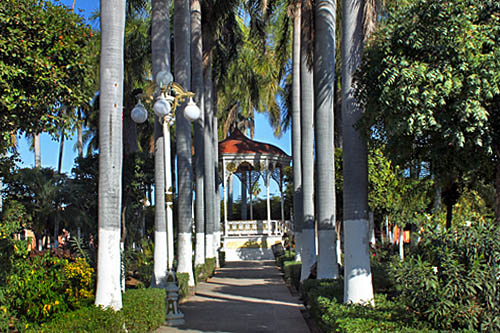
In the center, a filigreed gazebo shaded by tall palms was surrounded by splashing fountains, bronze sculptures, and park benches. Exquisite historic buildings bordered the park on all sides, but my eyes went immediately to the magnificent brick Palacio Municipal. Constructed between 1903 and 1907, the relative youth of the Palacio Municipal does not detract from its majestic appearance. Built in the traditional rectangle style with an open-air interior courtyard, the building occupies an entire city block. Five archways lead through its brick exterior to a sun-splashed inner courtyard with a burbling central fountain. Pink and peach bougainvillas frame two levels of salmon color arches all around, and an historic mural covers the stairwell leading to the second level.



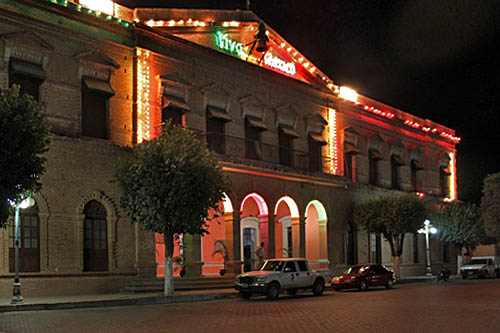
Much older but no less beautiful buildings anchor other sides of the square. El Fuerte’s principal church thrusts its pink and white tower high over a hand-laid stone chapel, while the white arches of Casa de los Portales mirrors the Palacio, directly across the park.
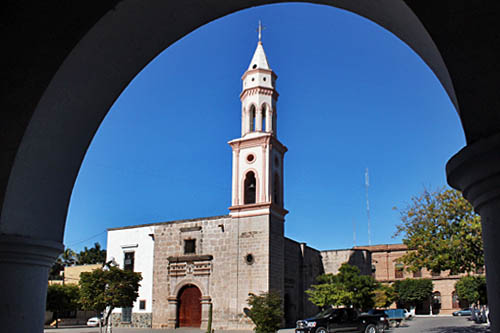
By virtue of its beauty and history, El Fuerte has won the designation of Magico Mexico – Magic Mexico – from the Mexican government, and it is easy to see why. Although the earliest buildings either crumbled or were demolished to make room for better buildings, many of the mansions built for wealthy residents of the town from the mid-1700’s to the early 1900’s have been perfectly maintained or restored. Painted in rich jewel tones and pastels, their five foot thick walls and giant wooden doors, which are customarily thrown wide to display lovely interior courtyards, offer a glimpse of days gone by.

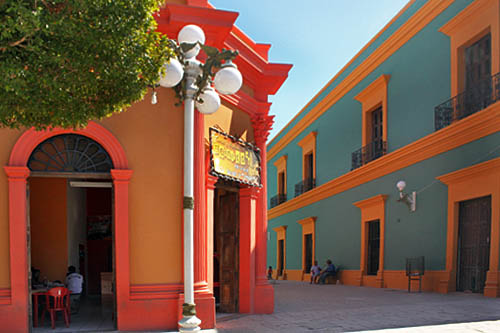
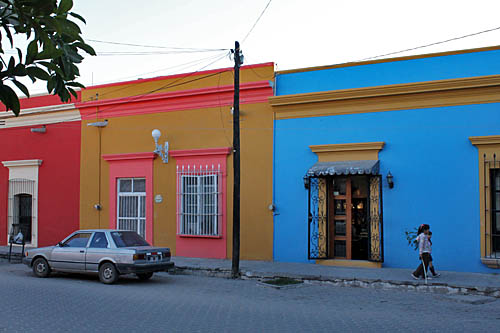
In 1564 the Spanish conqueror, Francisco de Ibarra, founded the town as San Juan de Carapoa, apparently because this occurred on June 24th, the day commemorating St. John and because the surrounding valley was named Carapoa. The town was deserted and repopulated three times, until Jesuit missionaries arrived in 1590. This was a change of strategy for the Spaniards; rather than subduing the hostile natives with swords and firearms, over the next 200 years the Jesuits won them over with good treatment and evangelism. By 1608, construction was underway on a fortress, built in a rectangular shape with thick adobe walls atop the hill in the center of town. The fort was named El Fuerte de Montesclaros and over time, the town simply became known as El Fuerte.
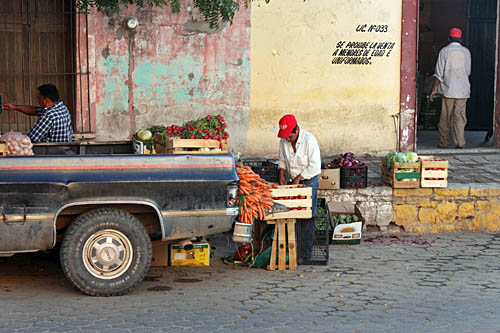
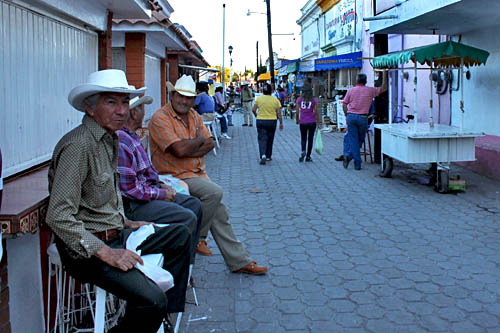
For many years El Fuerte was a simple, tranquil village but when gold and silver were discovered in the surrounding hills, its prominence and wealth grew. When Mexico won independence, the provinces of Sonora and Sinaloa were joined and El Fuerte was made its capital. The extensive western state encompassed El Rosario mine in the south and stretched to the Grand Canyon in what is today the state of Arizona in the U.S. The old manor house where the first Congress of the Western State met is still in existence, located on the corner of Morales and Augustina Ramirez streets. It is built of stone, in authentic colonial design, and is now divided into several private residences. In this house, in 1825, the first printing press in northwest Mexico was installed and used to publish the writings of the first independent government of Mexico.
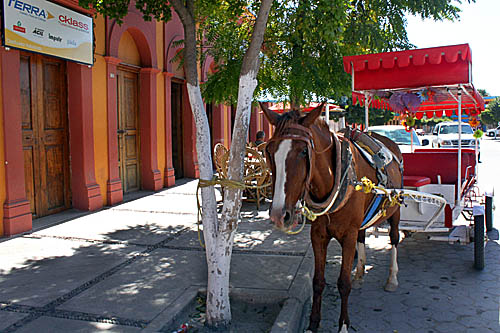
Around the time the vast Western State was divided into present day states of Sonora and Sinaloa in 1831, very wealthy families with names like Ibarra, Orrantia, Almada, Gaxiola, Delgado, and Vega established themselves as the ruling class and added to the town’s already impressive architecture. Descendants of these old families still reside in El Fuerte, as I witnessed during my stay when I happened upon a funeral for a man named Ibarra, who the residents described as “un vecino muy importante” – a very important neighbor.
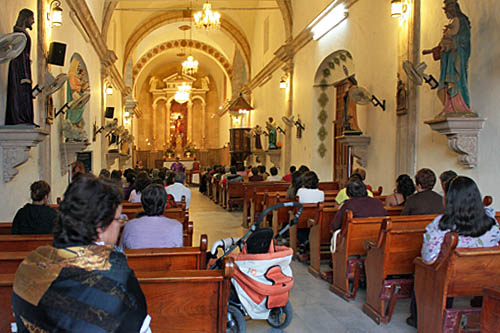

The funeral was almost as interesting as the town’s magnificent architecture. Following a midday church service, a flower-draped white hearse rode slowly through the narrow streets, followed by a procession of neighbors on foot and riding old bicycles. At the rear, two trucks towed trailers with musicians who played upbeat music with broad smiles, celebrating rather than mourning his life.
Although the original fort has long since disappeared, in 2001 the town constructed Museo Mirador El Fuerte, a replica of the original fort built atop the hill where it is thought to have been originally located. Though I visited the museum toward the end of my three day stay, I strongly recommend that visitors make this the first stop, as it contains an excellent collection of historical photos, machinery, and documentation about the history of the town and surrounding area.
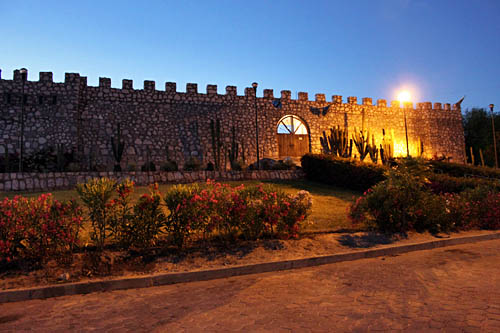
On my final evening in town, I strolled the half-mile long along Riverwalk, a wide stone walkway that follows the river on which (strangely) El Fuerte turns its back. Coming back up the hill, the sign in front of Hotel Posada del Hidalgo stopped me. “Mansion historica. Excelente cocina regional. Bar. Alberca. Palapa. Langostinos y lobina.” Historic mansion. Excellent regional food. Bar. Swimming pool. Palapa. Shrimp and lobster. Yet I had found no literature on this building.
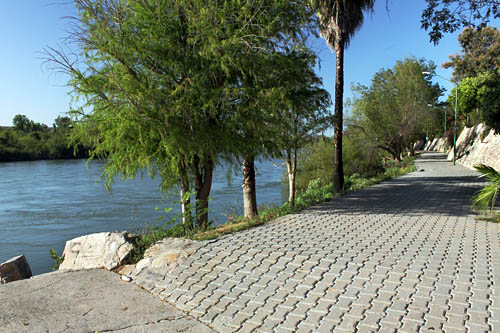

I struggled up the steep walkway with my bad knee and hip and landed smack in the middle of a group of people from southern Idaho who were part of a tour with Collette Vacations, one of the largest tour operators in the U.S. They adopted me like a newborn puppy and soon I was seated around a table with five terrific women, enjoying the floor show with three musicians and a singer dressed up as Zoro. And that is how I discovered that Posada del Hidalgo, a beautiful colonial mansion converted to a hotel and restaurant, is the house where the legendary Zorro spent the first ten years of his life. Finally, after stuffing myself with fresh roasted vegetables and rice, I headed back to my charming accommodations at Rio Vista Hotel to dream of colonial empires, rich gold mines, and midnight trysts with Zorro.
To be continued…..

I see that you did take pictures of El Fuerte. Just one correction the designation is called Pueblo Magico (Magical Town) and not Magico Mexico.
Hi Michael: Thanks for your comment. Though I visited El Fuerte more than a year ago, my recollection is that at the time they were still trying to get their “Pueblo Magico” designation – Magico Mexico was name they used to refer to the town in the interim. I am so glad to learn that they were finally successful. It is an exquisite little town filled with colonial architecture and they certainly deserve it.
Writing is great. However the photos are fab! Bueno
Gracias Nancy. I’m now in the Yucatan, furthest south portion near the Belizean border. Today I passed a ranch that offers “Vaquero” vacations and thought, “I need to tell Nancy about that place” for your “Writing Horseback” blog, and then I get this comment from you. How weird is that!
I love this article. It truely captures the beauty of El fuerte.
Great pictures! What an amazing place, your writing really makes me want to visit. I especially like the street and market photos.
Your photos really captured the essence of El Fuerte. Now I’d like to visit.
Wow – and you weren’t planning on going here originally?!
From your travels in Mexico I’m continuously surprised at how clean and developed the towns look. Lovely commentary on the city history!
What a most beautiful place. I love reading about the history of the place and the photos were so professioanl – such interesting angles and details. Wouldn’t you know that Zorro would appear! Great post.
Zorro would steal your cash, saying that there’s someone in greater need. Then the next day you’d see him buying an expensive new cloak with your money. The better-dressed they are, the vainer they are and the more obsessed with self-marketing, I reckon.
😉
I know, I know. No romance in my soul. Whatever.
Continuing to love your adventures. Bet you are too. And to reiterate what everyone’s said in their comments so far – Mexicans know what to do with colors. We could and should learn a lot from them.
The vibrant photos are stunning. They truly inspire travel.
I love those brightly painted building – that’s what I imagine all Mexico to be like although I’ve never been
As always, your photos transport the reader right to the place. Looks like a great place to visit in Mexico!
Great post and wonderful pictures. If on the off chance you’re into birding than a river cruise on the El Fuerte River sounds like a great thing to do. I think over 60 bird species can be spotted on a cruise.
I’ll look forward to reading about your Copper Canyon travels which is high on my wish list.
Hi Leigh. Thanks for the comment. You MUST come to Copper Canyon and visit Urique at the bottom. Watch for my upcoming posts!
Stunning colours. The pinkish building around the main square is really striking.
You and your readers might enjoy this video of the canyon made by an organization (One Heart World-Wide) that is working there now. If you get to the town of Urique or Guaplayana and would like to meet them they would be happy to show you around and introduce you to the community. (To get to Urique you take the El Chepe train to Bahuichivo and take the 4:00 PM bus down the canyon road to Urique (it is an incredible bus ride!).
http://roughfractals.blogspot.com/2010/02/one-heart-world-wide.html
I absolutely LOVE the colors in the photos of this post … absolutely stunning! How could a person help buy be happy and inspired with all the yellows and oranges?